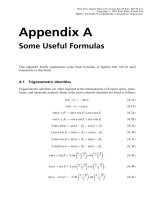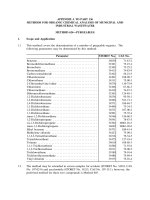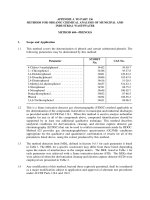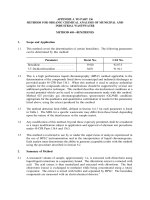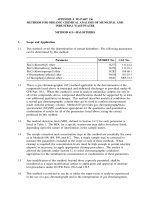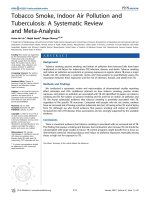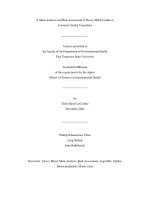Appendix A: Financial Literacy and Mathematics Education
Bạn đang xem bản rút gọn của tài liệu. Xem và tải ngay bản đầy đủ của tài liệu tại đây (665.28 KB, 13 trang )
Appendix A: Financial
Literacy and Mathematics
Education
of the
Mathematics Framework
for California Public Schools:
Kindergarten Through Grade Twelve
Adopted by the California State Board of Education, November 2013
Published by the California Department of Education
Sacramento, 2015
Appendix A
Financial Literacy and Mathematics Education
F
inancial literacy is defined as the knowledge, tools, and skills that are essential for effective
management of personal fiscal resources and financial well-being. Gaining mathematical
knowledge is the first step toward developing financial literacy, which in turn provides early
opportunities for meaningful mathematical modeling. The global economic downturn that occurred in
the late 2000s highlighted the need for increased financial education for school-age students as well
as adults. A 2009 survey conducted by the Financial Industry Regulatory Authority (FINRA) showed that
about half of the Americans surveyed had trouble keeping up with their monthly expenses. Members
of the same survey group were unable to save a portion of their income for emergencies or retirement
(FINRA Investor Education Foundation 2009). This inability to save money has even greater implications
for the future as the average life expectancy increases and people need more money to sustain themselves throughout their lives.
The President’s Advisory Council on Financial Capability (2012) states, “Research shows that low levels
of financial literacy are associated with high levels of indebtedness, lower wealth accumulation, and
less retirement savings.” Individuals with low levels of financial literacy are also particularly vulnerable
to predatory lending. In response to these troubling social trends, there have been movements in many
states across the country to increase the financial education of Americans, beginning in elementary
school and continuing through postsecondary education.
California has not adopted its own standards for financial literacy; however, there are two sets of
national standards that teachers may use to influence their instruction. The Jump$tart Coalition for
Personal Financial Literacy created and maintains the National Standards in K–12 Personal Finance
Education, available at (accessed May 28,
2014). These standards describe financial knowledge and skills that students should be able to exhibit.
The Jump$tart standards are organized under six major categories of personal finance:
• Financial Responsibility and Decision Making
• Income and Careers
• Planning and Money Management
• Credit and Debt
• Risk Management and Insurance
• Saving and Investing
California Mathematics Framework
Appendix A
781
The second set of national standards available to teachers is the National Standards for Financial
Literacy published by the Council for Economic Education (CEE). The CEE standards are available at
(accessed May 28, 2014) and, like the Jump$tart standards, are organized under six
major categories of personal finance:
• Earning Income
• Buying Goods and Services
• Saving
• Using Credit
• Financial Investing
• Protecting and Insuring
The standards in each category provide expectations for students’ financial knowledge and skills at
each grade level, but leave it to stakeholders to determine the methods for delivery. For example,
under Jump$tart’s Planning and Money Management category, the standards call for students to
develop a plan for spending and saving, keep and use a system for financial records, apply consumer
skills to purchasing decisions, and use other important money-management tools. A recent study
supported by the National Endowment for Financial Education and the Citi Foundation shows that
students who receive cumulative (repeated) financial education demonstrate more positive financial
behaviors as adults. In addition, the study documents that early exposure to financial education has
a positive impact on people’s lives (Serido and Shim 2011). In some cases, students have very positive
role models at home when it comes to financial decision making; however, other students may greatly
benefit from learning about these concepts and tools at school.
There are numerous Web resources available to teachers free of charge to support financial education
in schools. Links to these resources can be found at the end of this appendix, as well as on the
CDE’s K–12 Financial Literacy Resources Web page at />(accessed May 28, 2014).
Time constraints in the regular school day often make it impossible to offer a separate course in
financial education; however, financial literacy concepts can be integrated into other core content
areas. Mathematics courses are often considered a natural fit for the integration of financial literacy
exercises and skills. The California Common Core State Standards for Mathematics (CA CCSSM) provide
multiple entry points for the incorporation of problems or exercises that teach important financial
literacy concepts and skills—and the opportunity to teach financial literacy concepts is even more
evident in the real-world problems emphasized by the CA CCSSM. This includes the use of mathematical
modeling, which is included in every grade level in the standards (see appendix B for more information). In addition, the Standards for Mathematical Practice (MP) emphasize the analytical skills that
students will use when solving problems that involve financial literacy concepts. Although financial
literacy has a place in the mathematics classroom, analyzing financial situations and making decisions
based on the analysis is not pure mathematics per se. There are computational aspects of finance
782
Appendix A
California Mathematics Framework
problems and the various terms, definitions, and mathematical meanings that constitute the pure
mathematics in these problems. In addition, financial literacy problems provide students with rich
opportunities to hone their mathematical problem-solving skills within real-world contexts.
Teachers must find an appropriate balance when considering the integration of financial literacy into
the mathematics classroom. Standard 2.OA.1 asks students to “Use addition and subtraction within
100 to solve one- and two-step word problems involving situations of adding to, taking from, putting
together, taking apart, and comparing, with unknowns in all positions.” Students in second grade may
have some experience with doing chores at home to earn an allowance. They also may have had to
make choices about how to spend their money. Together with students’ experiences, standard 2.OA.1
provides opportunities to discuss concepts in the CEE’s financial literacy standards (Earning Income
and Buying Goods and Services) as well as Jump$tart’s financial literacy categories (Income and Careers
and Planning and Money Management). Consider the following word problem:
Lucy earns an allowance of $5 per week. She also walks her neighbor’s dog every day, earning $15 per
week. In addition, Lucy received a birthday gift of $20 from her aunt. In all, Lucy has three different
sources of income this week. Use column A in the following table to input Lucy’s income.
Column A: Income
Source
Amount ($)
Allowance
Dog walking
Birthday money
Column B: Expenses
Item
Amount ($)
$5
$15
$20
Savings
Total: $40
$5
Total:
How much is left over?
(Column A total minus Column B total): $
Lucy must decide how to spend her money. At the end of the week, she would also like to have $5 left
over to deposit into her savings account. She comes up with a list of possible ways to spend her money:
• Trip to the movies: $14
• Birthday gift for her brother: $10
• Favorite magazine: $4
• Donation to the local food bank: $5
• Materials for a school assignment: $7
• Money owed to her sister for a previous loan: $6
California Mathematics Framework
Appendix A
783
Follow-up financial literacy questions:
1. Does Lucy have enough money for all of these things?
2. How would you suggest that she spend her money?
Use column B in the previous table to show your suggestions for Lucy’s expenses (adapted from
Federal Reserve Bank of Cleveland 2007).
The standards for mathematics in middle school allow for more in-depth exercises that address
financial literacy concepts. For example, the seventh-grade standard 7.EE.4b reads as follows:
Solve word problems leading to inequalities of the form
or
, where , , and
are specific rational numbers. Graph the solution set of the inequality and interpret it in the
context of the problem. For example: As a salesperson, you are paid $50 per week plus $3 per sale.
This week you want your pay to be at least $100. Write an inequality for the number of sales you
need to make, and describe the solutions.
This standard has the potential to address several financial literacy categories in the Jump$tart
standards (Financial Responsibility and Decision Making; Income and Careers; Planning and Money
Management; and Saving and Investing) as well as three of the CEE’s financial literacy topics (Earning
Income; Buying Goods and Services; and Saving). Consider the following problem:
Darla works as a salesperson. Her monthly salary is $1000, and she can make an additional $25 per
sale. In order to pay her monthly bills, she must make at least $2750 per month. How many sales will
she need to make per month to meet her monthly financial obligations? The following table lists
Darla’s monthly expenses:
Expenses
Item
Amount ($)
Rent
Utility bills
Cell phone bill
Entertainment
Bus fares
Groceries
Credit card payments
Charitable contributions
Clothing purchases
$1200
$280
$75
$150
$105
$450
$240
$100
$150
Total: $2750
[Write an inequality for the number of sales she will need to make, and describe the solutions.]
784
Appendix A
California Mathematics Framework
Darla would like to save an additional $200 per month over the next year for a down payment on a
car. Considering the previous information, how many sales will she need to make per month? [Write an
inequality for the number of sales she will need to make, and describe the solutions.]
Once Darla purchases the car, her monthly car payment will be $300. How many sales will she need
to make each month in order to meet her monthly financial obligations, including the car payment?
[Write an inequality for the number of sales she will need to make, and describe the solutions.]
Follow-up financial literacy questions:
1. What additional costs associated with car ownership must Darla consider?
2. What risk is Darla taking when basing the total income she needs on the number of sales
she makes beyond her base salary?
3. Using the previous table that shows Darla’s monthly expenses, if her sales are lower than
expected for any given month, where might she cut some costs in order to afford her car?
In higher mathematics, the CA CCSSM allow for a more sophisticated discussion of financial management and decision making. For instance, the early use of recursively defined sequences (standard
F-IF.3) allows for a simpler and more intuitive discussion of compound interest (i.e.,
(principal),
for
); discount (i.e.,
(principal),
for
); and amortization
of debt (i.e.,
(principal),
−(payment) for
). These types of interest
and payment calculations can help students understand the origin of common formulas such as
.
In the conceptual category of Functions, standard F-BF.1 calls for students to “Build a function that
models a relationship between two quantities” (cluster heading) and specifically to “Determine an
explicit expression, a recursive process, or steps for calculation from a context” (F-BF.1a). Consider
the following problem concerning the cost of credit:
James arrived at college and was given two credit cards. He didn’t really know much about managing
his money, but he did understand how to use the cards—so he bought a few things for his dorm room,
including a television for $1200 and a microwave for $200. Each of the items was purchased with a
different credit card, and each card had a different interest rate. The television was purchased with
a card that had an 18% annual interest rate; the microwave was purchased with a card that had a
28% annual interest rate. James has a job. He earns $1500 per month and spends $900 per month on
school-related and living expenses.
1. What questions do you have about each credit card that would help you advise James on
how to pay off each of his debts? (For example, students might ask about the minimum
payments required for each card, late charges, and so forth.)
California Mathematics Framework
Appendix A
785
2. If James takes the amount of money he has left after paying his other expenses and splits it
between the two cards, how long would it take him to pay off each account?
3. What other options does James have for paying off the debts?
4. Which option would result in James paying the least amount of interest?
a) Write one or more equations to model the situation and support your answer.
b) What is the total amount of interest James will end up paying for each credit card?
CA CCSSM Alignment
Building Functions (F-BF)
Build a function that models a relationship between two quantities.
Mathematical Practices
1. Make sense of problems and persevere in solving them.
2. Reason abstractly and quantitatively.
3. Construct viable arguments and critique the reasoning of others.
4. Model with mathematics.
5. Use appropriate tools strategically.
When students are introduced to financial literacy education early in their academic lives, they can
develop a lifelong foundation for making intelligent decisions about how to earn, save, and invest
money. In many cases there is not enough time in the regular school day to offer a course in financial
literacy, and thus it is important to leverage opportunities in other core subject areas to include financial literacy lessons where appropriate. The CA CCSSM open many doors for examining and practicing
financial literacy topics, especially through the application of the Standards for Mathematical Practice
and real-world problems. It is important for mathematics instructors to find the appropriate balance
between teaching the mathematical standards and concepts and financial literacy skills.
The following table provides information about financial literacy word problems created by the Math
Forum @ Drexel that align with both sets of national financial literacy standards, as well as the content
and mathematical practices standards of the CA CCSSM. To view the actual word problems, please
visit (accessed May 28, 2014).
786
Appendix A
California Mathematics Framework
Grade Level
or Course
Name
of Word
Problem
Kindergarten The Yard
Sale
Standards for
Mathematical
Practice
MP.1: Make sense
of problems and
persevere in solving
them.
MP.3: Construct
viable arguments
and critique the
reasoning of others.
Grade 1
Jordan’s
Jobs
MP.1: Make sense
of problems and
persevere in solving
them.
MP.3: Construct
viable arguments
and critique the
reasoning of others.
Grade 2
Money
Matters
MP.1: Make sense
of problems and
persevere in solving
them.
MP.3: Construct
viable arguments
and critique the
reasoning of others.
Grade 3
Miracle
Miranda
and the
Mascot
MP.1: Make sense
of problems and
persevere in solving
them.
MP.3: Construct
viable arguments
and critique the
reasoning of others.
MP.5: Use appropriate tools strategically.
MP.7: Look for
and make use of
structure.
Standards for
Mathematical Content1
CEE National Jump$tart
Standard
Standard
Operations and Algebraic
Thinking: Solve addition
and subtraction word
problems, and add and
subtract within 10, e.g., by
using objects or drawings
to represent the problem.
(K.OA.2)
Standard II:
Buying
Goods and
Services
Planning
and Money
Management,
Standard 4:
Apply consumer skills
to purchase
decisions.2
Operations and Algebraic
Thinking: Solve word problems that call for addition
of three whole numbers
whose sum is less than or
equal to 20, e.g., by using
objects, drawings, and
equations with a symbol
for the unknown number
to represent the problem.
(1.OA.2)
Standard I:
Earning
Income
Planning
and Money
Management,
Standard 4:
Apply consumer skills
to purchase
decisions.
Operations and Algebraic
Thinking: Represent and
solve problems involving
addition and subtraction.
(2.OA cluster heading)
Standard II:
Buying
Goods and
Services
Planning
and Money
Management,
Standard 4:
Apply consumer skills
to purchase
decisions.
Operations and Algebraic
Thinking: Solve two-step
word problems using the
four operations.
Represent these
problems using equations
with a letter standing for
the unknown quantity.
Assess the reasonableness
of answers using mental
computation and estimation strategies including
rounding. (3.OA.8)
Standard I:
Earning
Income
Income and
Careers,
Standard 2:
Identify
sources of
personal
income.
1
1. For some examples in this column, cluster headings are listed rather than standards.
2. The correct term is purchasing decisions, but the Jump$tart standards use the term purchase decisions.
C alifornia Mathematics Framework
Appendix A
787
Grade Level
or Course
Grade 4
Name of
Word
Problem
Building
Bouquets
Standards for
Mathematical
Practice
MP.1: Make sense
of problems and
persevere in solving
them.
MP.3: Construct
viable arguments
and critique the
reasoning of others.
Grade 5
Super
MP.1: Make sense
Salsa Deal of problems and
persevere in solving
them.
MP.3: Construct
viable arguments
and critique the
reasoning of others.
MP.5: Use appropriate tools strategically.
Grade 6
Buying
Cola
MP.6: Attend to
precision.
MP.1: Make sense
of problems and
persevere in solving
them.
MP.3: Construct
viable arguments
and critique the
reasoning of others.
788
Appendix A
Standards for
Mathematical Content1
CEE National Jump$tart
Standard
Standard
Operations and Algebraic
Thinking: Find all factor
pairs for a whole number in
the range 1–100. Recognize
that a whole number is a
multiple of each of its factors. Determine whether a
given whole number in the
range 1–100 is a multiple of
a given one-digit number.
Determine whether a given
whole number in the range
1–100 is prime or composite. (4.OA.4)
Number and Operations
in Base Ten: Add, subtract,
multiply, and divide
decimals to hundredths,
using concrete models or
drawings and strategies
based on place value,
properties of operations,
and/or the relationship
between addition and
subtraction; relate the
strategy to a written
method and explain the
reasoning used. (5.NBT.7)
Standard I:
Earning
Income
Income and
Careers,
Standard 2:
Identify
sources of
personal
income.
Standard II:
Buying
Goods and
Services
Planning
and Money
Management,
Standard 4:
Apply consumer skills
to purchase
decisions.
Ratios and Proportional
Relationships: Understand
the concept of a unit rate
associated with a ratio
with
, and use rate
language in the context of a
ratio relationship. For example, “This recipe has a ratio
of 3 cups of flour to 4 cups
of sugar, so there is cup of
flour for each cup of sugar.”
“We paid $75 for 15 hamburgers, which is a rate of $5
per hamburger.” (6.RP.2)
Standard II:
Buying
Goods and
Services
Planning
and Money
Management,
Standard 4:
Apply consumer skills
to purchase
decisions.
California Mathematics Framework
Grade Level
or Course
Grade 7
Grade 8
Name of
Word
Problem
That’s
Interesting!
Saving
Your
Raise
Standards for
Mathematical
Practice
MP.1: Make sense of
problems and persevere in solving them.
Standards for
Mathematical Content1
Ratios and Proportional
Relationships: Use proportional relationships to solve
MP.3: Construct viable multi-step ratio and percent
problems. Examples: simple
arguments and
critique the reasoning interest, tax, markups and
markdowns, gratuities and
of others.
commissions, fees, percent
MP.4: Model with
increase and decrease, percent
mathematics.
error. (7.RP.3)
MP.5: Use appropriate
tools strategically.
MP.1: Make sense of
Expressions and Equations:
problems and perse- Know and apply the propervere in solving them.
ties of integer exponents to
MP.2: Reason
generate equivalent numeriabstractly and
cal expressions. For example,
quantitatively.
.
MP.3: Construct viable
(8.EE.1)
arguments and
critique the reasoning
of others.
CEE National Jump$tart
Standard
Standard
Standard III
(Saving) and
Standard IV
(Financial
Investing)
Saving and
Investing,
Standard 3:
Evaluate
investment
alternatives.
Standard III: Saving and
Saving
Investing,
Standard 2:
Explain how
investing
builds
wealth and
helps meet
financial
goals.
MP.4: Model with
mathematics.
MP.5: Use appropriate
tools strategically.
Algebra I,
Dinner
MP.1: Make sense of
Algebra, Reasoning with
Mathematics I at Pepe’s problems and perse- Equations and Inequalities:
vere in solving them. Explain each step in solving a
MP.3: Construct viable simple equation as following
from the equality of numbers
arguments and
critique the reasoning asserted at the previous step,
starting from the assumption
of others.
that the original equation
MP.4: Model with
has a solution. Construct a
mathematics.
viable argument to justify a
solution method. (A-REI.1)
Algebra, Creating Equations:
Create equations and
inequalities in one variable
including ones with absolute
value and use them to solve
problems. Include equations
arising from linear and quadratic functions, and simple
rational and exponential
functions. CA (A-CED.1)
California Mathematics Framework
Standard II:
Buying
Goods and
Services
Financial
Responsibility and
Decision
Making,
Standard 5:
Develop
communication
strategies
for discussing financial
issues.
Appendix A
789
Grade Level or Name of
Course
Word
Problem
Algebra I,
Credit
Mathematics II Card
Payoff
Options
Standards for
Mathematical
Practice
MP.1: Make sense
of problems and
persevere in solving
them.
MP.2: Reason
abstractly and
quantitatively.
MP.3: Construct
viable arguments
and critique the
reasoning of others.
MP.4: Model with
mathematics.
MP.5: Use
appropriate tools
strategically.
Statistics and
Probability
A Great
Way to
Make
Money
MP.1: Make sense
of problems and
persevere in solving
them.
MP.3: Construct
viable arguments
and critique the
reasoning of others.
Calculus
College
Savings
MP.1: Make sense
of problems and
persevere in solving
them.
MP.2: Reason
abstractly and
quantitatively.
MP.3: Construct
viable arguments
and critique the
reasoning of others.
Standards for
Mathematical Content1
CEE National Jump$tart
Standard
Standard
Algebra, Seeing Structure
in Expressions: Use the
properties of exponents
to transform expressions
for exponential functions.
For example, the expression
can be rewritten as
to
reveal the approximate
equivalent monthly interest
rate if the annual rate is
15%. (A-SSE.3c)
Standard IV:
Using Credit
Credit and
Debt,
Standard 1:
Identify the
costs and
benefits of
various types
of credit.
Algebra, Building
Functions: Build a function
that models a relationship
between two quantities.
(F-BF cluster heading)
Statistics and Probability:
Standard
Using Probability to Make
I: Earning
Decisions: (+)
Income
Calculate the expected value
of a random variable; interpret it as the mean of the
probability distribution.
(S-MD.2)
Saving and
Investing,
Standard
3: Evaluate
investment
alternatives.
Calculus: Students demon- Standard III:
strate an understanding of
Saving
the interpretation of the
derivative as an instantaneous rate of change.
Students can use derivatives
to solve a variety of
problems from physics,
chemistry, economics, and
so forth that involve the
rate of change of a function.
(Calculus 4.2)
Saving and
Investing,
Standard 2:
Explain how
investing
builds wealth
and helps
meet financial goals.
MP.4: Model with
mathematics.
790
Appendix A
California Mathematics Framework
Grade Level or
Course
Name of
CEE
Standards for
Jump$tart
Standards for
Word
Mathematical
Mathematical Content1 National Standard
Problem
Standard
Practice
The following lesson plan was produced by the Mathematics Assessment Resource Service (MARS).
See (accessed July 24, 2014) for more
information.
Algebra II,
Comparing MP.1: Make sense of
Algebra: Seeing
Mathematics II/III Investments problems and persevere Structure in Expressions
in solving them.
Functions: Linear,
MP.2: Reason abstractly
Quadratic, and
and quantitatively.
Exponential Models
MP.4: Model with
mathematics.
MP.7: Look for and make
use of structure.
Financial Literacy Curriculum Resources
California Department of Education. 2014. Grades K–12 Financial Literacy Resources.
(accessed May 28, 2014).
Council for Economic Education. 2014. Online Economic Lessons. />economic-lesson-search.php?type=educator (accessed May 28, 2014).
Curators of the University of Missouri. 2008. Money Math: Lessons for Life. asurydirect.
gov/indiv/tools/tools_moneymath.pdf (accessed May 28, 2014).
Federal Reserve. 2014. Lesson Plans. />lesson-plans/ (accessed May 28, 2014).
Federal Reserve Bank of Atlanta. 2014. Education Resources. />extracredit/lessons_activities.cfm (accessed May 28, 2014).
Federal Reserve Bank of Cleveland. 2007. Great Minds Think: A Kid’s Guide to Money.
/>Think.pdf [Link no longer valid.] (accessed May 28, 2014).
Federal Reserve Bank of Dallas. 2013. Building Wealth: A Beginner’s Guide to Securing Your Financial
Future. (accessed May 28, 2014).
Federal Reserve Bank of New York. 2009. It’s All About Your $: A Teacher’s Guide. />education/its_all_about_your_money.pdf [Link no longer valid.](accessed May 28, 2014).
. n.d. Econ Explorers: Journal for Students. />education/ econ_student.pdf [Link no longer valid] (accessed May 28, 2014).
Federal Reserve Bank of Philadelphia. 2014. Lesson Plans for Teachers. />education/teachers/lesson-plans/ (accessed May 28, 2014).
Mathematics Assessment Resource Service (MARS). 2014. Mathematics Assessment Project.
(accessed June 26, 2014).
The Math Forum @ Drexel. 2014. (accessed May 28, 2014).
C alifornia Mathematics Framework
Appendix A
791
This page intentionally blank.
